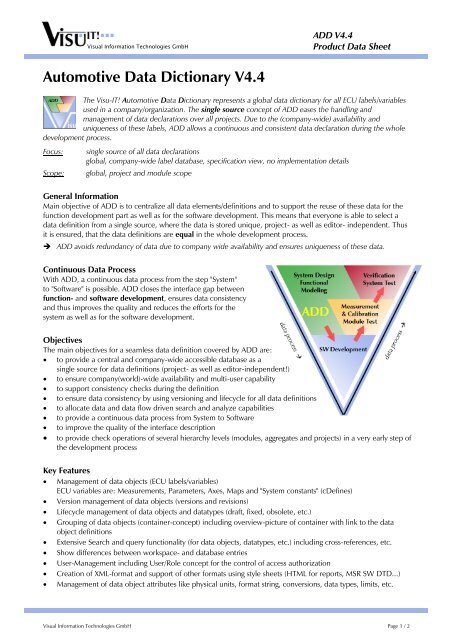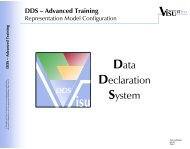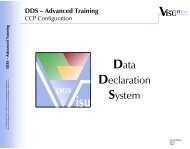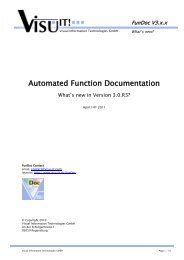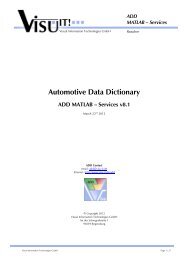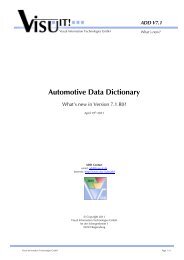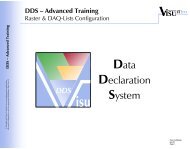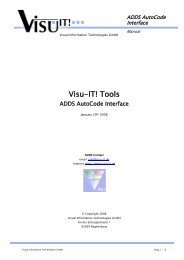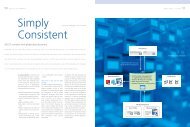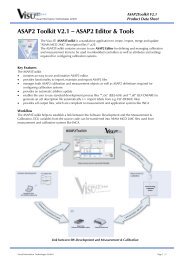Automotive Data Dictionary V4.4 - Visu
Automotive Data Dictionary V4.4 - Visu
Automotive Data Dictionary V4.4 - Visu
You also want an ePaper? Increase the reach of your titles
YUMPU automatically turns print PDFs into web optimized ePapers that Google loves.
<strong>Visu</strong>al Information Technologies GmbH<br />
<strong>Automotive</strong> <strong>Data</strong> <strong>Dictionary</strong> <strong>V4.4</strong><br />
ADD <strong>V4.4</strong><br />
Product <strong>Data</strong> Sheet<br />
The <strong>Visu</strong>-IT! <strong>Automotive</strong> <strong>Data</strong> <strong>Dictionary</strong> represents a global data dictionary for all ECU labels/variables<br />
used in a company/organization. The single source concept of ADD eases the handling and<br />
management of data declarations over all projects. Due to the (company-wide) availability and<br />
uniqueness of these labels, ADD allows a continuous and consistent data declaration during the whole<br />
development process.<br />
Focus: single source of all data declarations<br />
global, company-wide label database, specification view, no implementation details<br />
Scope: global, project and module scope<br />
General Information<br />
Main objective of ADD is to centralize all data elements/definitions and to support the reuse of these data for the<br />
function development part as well as for the software development. This means that everyone is able to select a<br />
data definition from a single source, where the data is stored unique, project- as well as editor- independent. Thus<br />
it is ensured, that the data definitions are equal in the whole development process.<br />
ADD avoids redundancy of data due to company wide availability and ensures uniqueness of these data.<br />
Continuous <strong>Data</strong> Process<br />
With ADD, a continuous data process from the step "System"<br />
to "Software" is possible. ADD closes the interface gap between<br />
function- and software development, ensures data consistency<br />
and thus improves the quality and reduces the efforts for the<br />
system as well as for the software development.<br />
Objectives<br />
The main objectives for a seamless data definition covered by ADD are:<br />
to provide a central and company-wide accessible database as a<br />
single source for data definitions (project- as well as editor-independent!)<br />
to ensure company(world)-wide availability and multi-user capability<br />
to support consistency checks during the definition<br />
to ensure data consistency by using versioning and lifecycle for all data definitions<br />
to allocate data and data flow driven search and analyze capabilities<br />
to provide a continuous data process from System to Software<br />
to improve the quality of the interface description<br />
to provide check operations of several hierarchy levels (modules, aggregates and projects) in a very early step of<br />
the development process<br />
Key Features<br />
Management of data objects (ECU labels/variables)<br />
ECU variables are: Measurements, Parameters, Axes, Maps and "System constants" (cDefines)<br />
Version management of data objects (versions and revisions)<br />
Lifecycle management of data objects and datatypes (draft, fixed, obsolete, etc.)<br />
Grouping of data objects (container-concept) including overview-picture of container with link to the data<br />
object definitions<br />
Extensive Search and query functionality (for data objects, datatypes, etc.) including cross-references, etc.<br />
Show differences between workspace- and database entries<br />
User-Management including User/Role concept for the control of access authorization<br />
Creation of XML-format and support of other formats using style sheets (HTML for reports, MSR SW DTD...)<br />
Management of data object attributes like physical units, format string, conversions, data types, limits, etc.<br />
<strong>Visu</strong>al Information Technologies GmbH Page 1 / 2
<strong>Visu</strong>al Information Technologies GmbH<br />
ADD <strong>V4.4</strong><br />
Product <strong>Data</strong> Sheet<br />
Process flow & Interfaces<br />
The following figure shows possible interfaces of ADD to other tools and the principal process flow:<br />
By providing a smart and flexible interface to DDS, all interfaces of DDS (like ASAP2, ELF, I3E, CVX, etc.) are<br />
implicitly also available in ADD.<br />
System Requirements<br />
Operating System Windows XP, Windows 2000<br />
Environment .NET Framework V2.0, Oracle V10.x Client or higher with Oracle <strong>Data</strong> Provider for<br />
.NET 2.0 (10.2.0.2.20)<br />
Processor Pentium 3 or equivalent, 750 MHz or higher<br />
Hard disk 100 MB (minimum) of free hard disk space<br />
System memory 512 MB of main memory<br />
Display resolution 1280 x 800, 16bit colors, 17 inch<br />
Contact<br />
<strong>Visu</strong>-IT! GmbH<br />
An der Schergenbreite 1<br />
93059 Regensburg<br />
Phone: +49 (0)9947 / 9040004<br />
Fax: +49 (0)941 / 49082 – 19<br />
Email: add@visu-it.de<br />
Internet: http://www.visu-it.de/add<br />
<strong>Visu</strong>al Information Technologies GmbH Page 2 / 2


